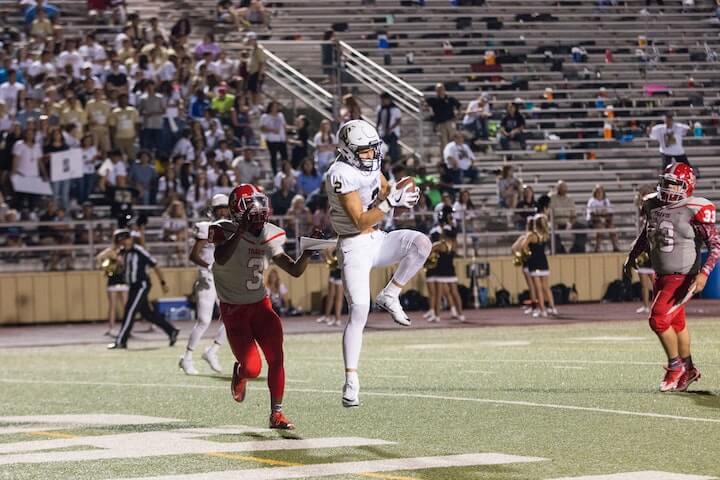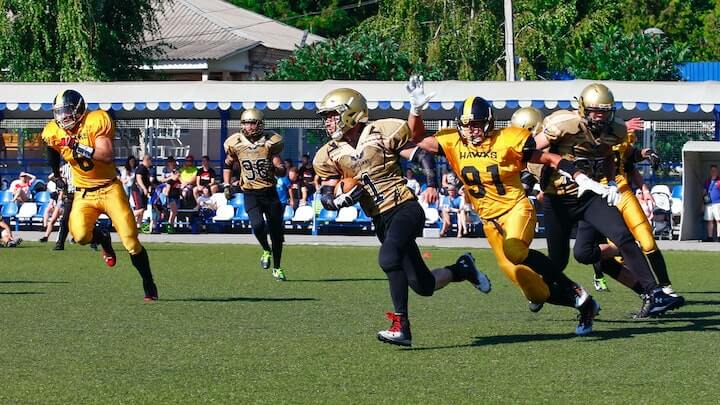The main routes on the "receiver route tree" are the basic patterns all wide receivers, tight ends, and even running backs must learn.
They form the basis of just about every route that a receiver will run during a pass play to try to get open.
As receivers master the art of each of these passing routes, they will often have to learn slight *variations* of these.
One of these variations is the Skinny Post route -- which is slightly different from the typical Post route.
There are reasons why coaches will employ the Skinny Post as they look to take advantage of something they see in the defense for big yardage gains.
There are also ways that the Skinny Post can help receivers get open and confuse defenses at the same time.
Let's take a closer look at what the Skinny Post route is, and how teams should run it from start to finish.
What is a Skinny Post Route?
A Skinny Post route is basically a Post route that takes a slightly less sharp angle to the middle of the field.
A Skinny Post will start with the receiver sprinting straight downfield for a certain number of yards. Then, he will angle in toward the middle of the field as he continues to sprint downfield.
Like the Post Route, the Skinny Post is a deep passing route that tries to get the receiver open "over the top" of the defense.
Where the Skinny Post differs is in the angle that the receiver will take toward the middle of the field.
Check out this example:
The Difference Between a Skinny Post and Regular Post
Again, the main difference between a Skinny Post and a Regular Post is the angle the receiver will take as he breaks his route from a straight Go to a Post.
In a regular Post route, the receiver will take about a 45-degree angle toward the middle of the field. But with a Skinny Post, this angle will be much shallower.
Generally speaking, the receiver will take a 20- to 25-degree cut.
This will keep him a little closer to the sideline or the outside of the field in his route than a regular Post does.

Why Run the Skinny Post?
Offensive coaches will call a Skinny Post for a number of reasons:
1. To Avoid the Opposing Safety
The main reason is that it can help the receiver avoid the safety.
In a regular Post pattern, the 45-degree cut to the middle will put the receiver near either the free safety or strong safety.
If the safeties are playing zone, they would be able to get over to the receiver to cover him after his cut.
What a Skinny Post does is make it harder for the safety to get over and provide over-the-top help to the cornerback.
With the shallower angle toward the middle, the receiver will stay further away from the safety, forcing them to run longer toward the sideline.
2. Making use of the Sideline
In addition, the Skinny Post's shallower angle will allow the receiver to use the sideline to his advantage.
He can make the catch in stride and then get to the outside, where there aren't likely to be any defenders.
3. Confuse the Defense
Finally, the Skinny Post allows the receiver to keep defenders guessing.
The defense will have to try to predict whether the receiver is running a straight Go route or a traditional Post.
By running something in between those two routes, the receiver might be able to leave the defenders in the dust.
Where to Run the Skinny Post From
Traditionally, teams run a Post route from one of the outside receiver positions.
The reason for this is that the 45-degree angle is sharp enough that it requires more room on the field to complete.
If team run a regular Post from the inside receiver, for example, that receiver may run out of room on the field (i.e. get too close to the sideline) before completing a pass.
The shallower angle of the Skinny Post allows it teams to run it from any receiver position on the field.

How to Run the Skinny Post
For the most part, the Skinny Post will is just like the regular Post route.
At the snap, the receiver should sprint straight downfield.
After about 10 to 15 yards, he should take a slight angle (about 20-25 degrees) toward the middle of the field.
To make this cut, the receiver will need to put some pressure on his outside foot in order to make the cut toward the middle.
Put weight on the outside of that foot, and then push off toward the middle.
He won't need to put too much pressure on it as the angle he's taking to the middle isn't as sharp as a regular Post.
The receiver also must remember that he'll be sprinting downfield the entire time.
The Skinny Post is a deep pattern, with the goal being the quarterback hitting the receiver in stride for a long completion.
This isn't possible if the receiver isn't sprinting downfield for the entirety of the route.
Conclusion
The Skinny Post is a nice variation on the regular Post route that takes a shallower angled cut to the middle of the field.
Because of this, the receiver is able to avoid a safety over the top.
Teams can also run the Skinny Post from any position on the field, unlike a regular Post, which is mainly a fit for outside receivers.
After players on your team master the regular Post route -- and others on the route tree -- teach them the nuances of the Skinny Post so you can incorporate it into your playbook.

